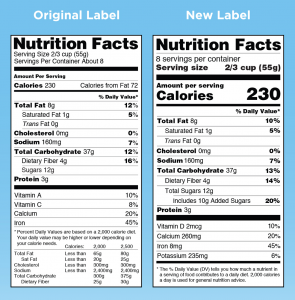Eating Habits Have Changed
Can you believe it was 1993 when the Food and Drug Administration (FDA) introduced the first “Nutrition Facts” label for food and beverage packages? For the past 26 years, consumers have used the food label to select more healthful foods. However, our eating habits, food supply, and consumption trends have changed so much since then. It was time for a new and improved food label that better reflects our actual eating habits, newer food products, and their relationship to increased prevalence of chronic illnesses including obesity, type 2 diabetes, hypertension, and heart disease. Hence, the FDA announced on May 20, 2016 a fresh format and improved “Nutrition Facts” label based on updated research-based information.
Due to the magnitude of these changes, FDA has indicated requirement deadlines for implementation based on the size of the food manufacturer. Food manufactures that generate at least $10 million in yearly sales have until 2020 to make the changes. Food manufacturers that generate less than $10 million in yearly sales have until 2021. Many food manufacturers have already switched over to the new food label, which is why you still see food products with one or the other version of the food label. Click here to take a closer look at the FDA’s current and new nutrition facts labels.
The New Nutrition Facts Label

https://www.fda.gov/media/97999/download
The new nutrition facts label features several enhancements to increase our knowledge about food products making it easier to select healthful foods. One of the biggest changes is larger serving sizes. The FDA is required by law to regulate serving sizes based on actual food and beverage consumption. It is no surprise that portion sizes have increased significantly over the past quarter century. According to current consumption statistics, serving sizes on the new food label have increased to better reflect the typical American diet. Do you remember the size of a hamburger, bagel, or even a pizza slice 20 years ago? You will be amazed to see how much they have increased. Check out the National Heart, Lung and Blood Institute’s Portion Distortion quizzes to see how much food portions have increased over time.
Other improvements to the new food label besides a new design include the addition of added sugars, vitamin D, and potassium; update of % daily value for several nutrients; and the removal of calories from fat, vitamin A and vitamin C. Click here to visit the FDA’s website for more information about the new nutrition facts label.
 0
0
